Why this resume works
- Quantifies accomplishments: The applicant’s measurable accomplishments, such as their ability to maintain over 150 machines with a 98% uptime, showcase their impact.
- Showcases career progression: Starting as a mechanical technician and progressing to equipment technician, the applicant’s career trajectory highlights growing responsibilities and achievements in improving efficiency and cost management.
- Uses action-oriented language: Strong action verbs like “maintained,” “reduced,” and “negotiated” effectively convey the applicant’s proactive approach and strong initiative.
More Equipment Technician Resume Examples
Check out our medical equipment technician resume examples to understand how to highlight your technical skills, maintenance experience, and problem-solving abilities. These medical resume samples will help you create a resume that stands out in the industry.
Entry-Level Equipment Technician
Why this resume works
- Effective use of keywords: Strategically weaving in industry terms like “equipment maintenance” and “troubleshooting,” the applicant optimizes their resume for keywords that align with medical equipment technician roles.
- Shows digital literacy: The inclusion of skills such as technical support and inventory management showcases digital literacy, aligning with computer skills needed in today’s tech-driven environments.
- Centers on academic background: Highlighting academic accolades like a master’s degree in mechanical engineering signals a strong foundation for medical equipment technician roles.
Mid-Level Equipment Technician
Why this resume works
- Points to measurable outcomes: Quantifiable achievements like improving machine efficiency by 15% and saving $20K with safety protocols showcase the applicant’s ability to deliver measurable operational improvements across roles.
- Demonstrates language abilities: Language skills in Spanish, German, and French improve cross-cultural communication, supporting broader collaboration.
- Displays technical expertise: Certifications such as advanced maintenance strategy paired with skills like precision calibration emphasize the applicant’s technical expertise and readiness for specialized equipment-focused responsibilities.
Experienced Equipment Technician
Why this resume works
- Lists relevant certifications: The applicant’s certifications in maintenance and reliability showcase their dedication to industry standards and continuous learning, reinforcing their technical expertise.
- Showcases impressive accomplishments: By emphasizing achievements such as saving $100K annually through equipment plans, the accomplishments reflect a significant impact on business operations.
- Emphasizes leadership skills: Managing teams to achieve zero incident rates highlights the applicant’s strong leadership skills and ability to foster a safe, efficient work environment.
Equipment Technician Resume Template (Text Version)
Jane Williams
Indianapolis, IN 46205
(555)555-5555
Jane.Williams@example.com
Professional Summary
Detail-oriented Equipment Technician with 4 years experience in optimizing machinery operations. Proven track record of reducing costs by 20% and enhancing machine uptime by 98%. Skilled in troubleshooting and process improvements.
Work History
Equipment Technician
TechPro Solutions – Indianapolis, IN
April 2023 – August 2025
- Maintained 150+ machines with 98% uptime
- Reduced repair costs by 20% annually
- Trained 5 junior technicians in 6 months
Maintenance Specialist
PrimeGear Services – Greenfield, IN
January 2021 – March 2023
- Improved machine efficiency by 30%
- Led team ensuring 95% repair task completion
- Negotiated vendor contracts saving $10K/year
Mechanical Technician
Precision Equipments – Indianapolis, IN
August 2019 – December 2020
- Oversaw equipment upgrades increasing output by 15%
- Developed preventative maintenance plan cutting downtime
- Assisted in design improvements saving $5K
Skills
- Equipment Maintenance
- Mechanical Troubleshooting
- Preventative Maintenance
- Technical Training
- Vendor Negotiation
- Process Improvement
- Machine Repair
- Technical Documentation
Education
Master’s Degree Mechanical Engineering
Georgia Tech Atlanta, GA
May 2019
Bachelor’s Degree Industrial Technology
University of Florida Gainesville, FL
May 2017
Certifications
- Certified Equipment Technician – National Tech Board
- Maintenance Management Certification – Tech Skills Institute
Languages
- Spanish – Beginner (A1)
- German – Beginner (A1)
- French – Beginner (A1)
Related Resume Guides
- Clinical Documentation Improvement Specialist
- Clinical Project Manager
- Clinical Research Assistant
- Clinical Trial Associate
- Coding Specialist
- Dermatologist
- Dialysis Technician
- Doctor
- Electrocardiograph Technician
- Emergency Department Technician
- Emergency Room Registration Clerk
- Health Information Technician
- Hospital Administrator
- Hospital Volunteer
- Intake Coordinator
- Intensive Care Physician
- Medical Laboratory Technologist
- Medical Records Specialist
- Medical Representative
- Medical Research Assistant
- Midwife
- MRI Technologist
- Neurosurgeon
- Nuclear Medicine Technologist
- OB-GYN Medical Assistant
- Ophthalmologist
- Ophthalmology Assistant
- Optometrist
- Orthopedic Surgeon
- Pediatric Assistant
- Pediatrician
- Physician
- Physician Assistant
- Podiatrist
- Psychiatrist
- Radiologist
- Radiology Technician
- Resident Medical Officer
- Respiratory Therapist
- Speech Language Pathologist
- Surgeon
- Surgery Scheduler
- Ultrasound Technician
Advice for Writing Your Equipment Technician Resume
Dive into our advice section on how to write a resume for a medical equipment technician position and discover how to highlight your technical skills and hands-on experience. Whether you’re troubleshooting machinery or maintaining complex systems, these tailored tips will help you stand out in the field.

Highlight relevant technical skills
For an equipment technician, technical skills are essential to performing the job accurately and safely. You can either create a dedicated skills section or include these abilities within your work experience details, making it easy for employers to see your qualifications at a glance. Highlighting these skills shows that you can properly maintain, repair, and operate medical devices that support patient care.
List common skills for this role, such as troubleshooting, preventive maintenance, calibration, installation, and repair of medical equipment. The ability to read and interpret service manuals, schematics, and technical documentation is also valuable. Experience with diagnostic software, electronic testing tools, and computerized maintenance systems can help set you apart.
If you have worked with specific equipment, such as patient monitors, infusion pumps, ventilators, or imaging systems, be sure to mention it. Tailor your skills to match the job description closely. For example, if the position emphasizes biomedical equipment servicing or regulatory compliance, highlight your experience in those areas.
Use clear and straightforward language so hiring managers can quickly recognize your expertise. By presenting your technical abilities in detail, you demonstrate that you are well prepared for the responsibilities of a medical equipment technician.
Example of a technical skills section
- Equipment maintenance and repair
- Troubleshooting electrical and mechanical systems
- Use of diagnostic tools and software (Fluke, multimeters, oscilloscopes)
- Pneumatics and hydraulics systems knowledge
- Reading blueprints and technical manuals
- Soldering and circuit board assembly
- Calibration of equipment and instruments
- Inventory management software (SAP, Oracle)
- Safety protocols and compliance standards
- Preventive maintenance procedures
You can use our Resume Builder to craft a resume that highlights technical skills in addition to key soft skills like teamwork, communication, and adaptability.
Quantify your accomplishments
Quantifying accomplishments in a resume helps transform routine responsibilities into meaningful achievements. For a medical equipment technician, simply listing tasks like “repaired equipment” or “performed maintenance” doesn’t show the true impact of your work.
Instead, focus on how your efforts improved reliability, reduced costs, or supported patient care. For example, you might write, “Increased equipment uptime by 25% through proactive preventive maintenance.” This highlights both your technical skills and the value you added.
In the work experience section, include your job title, employer name, location, and employment dates. To make this section stronger, convert duties into results with measurable outcomes. If you streamlined preventive maintenance schedules, mention how it reduced service delays.
If you ensured regulatory compliance, note audit results or inspection pass rates. Using percentages, dollar amounts, or time saved makes your achievements more concrete and compelling.
By presenting quantified accomplishments, you show hiring managers the real impact of your work as a medical equipment technician. Numbers make your contributions clear, whether it’s reducing downtime, improving patient safety, or saving the hospital money on repairs and replacements.
5 equipment technician work history bullet points
- Diagnosed and repaired equipment malfunctions, decreasing downtime by 25% through efficient troubleshooting techniques.
- Conducted routine maintenance checks on over 150 machines monthly, ensuring operational reliability and reducing potential failures by 30%.
- Collaborated with the engineering team to redesign machine components, improving performance and extending equipment lifespan by 20%.
- Implemented a new inventory management system, improving parts availability and reducing repair waiting time by 40%.
- Led training sessions for junior technicians on best practices in equipment handling, increasing team efficiency by 15%.
Need some ideas for your resume? Check out professional resume examples to see how others highlight their skills and experiences!
Write a powerful professional summary
A professional summary is a snapshot at the top of your resume that grabs attention and tells hiring managers who you are. It sums up your experience, skills, and achievements in a few sentences. You can choose between a professional summary or an objective to start your resume.
This type of summary highlights your past work, skills, and successes. It’s ideal for those with solid experience, like equipment technicians who have been in the field for years. This section shows what you’ve done and why you’re valuable to employers, painting a clear picture of your career journey.
On the other hand, resume objectives focus on what you want to achieve, making them best for newbies or those switching careers. They’re more about future goals than past accomplishments. Think “what I aim to contribute” with objectives versus “what I’ve accomplished” with summaries.
Now we’ll dive into examples of both summaries and objectives across different industries and levels of experience so you can see how they fit various roles and backgrounds.
Equipment technician resume summary examples
Entry-level
Recent graduate with an Associate degree in electronics engineering technology, eager to apply foundational skills in equipment maintenance and repair. Completed internship at a manufacturing plant focusing on troubleshooting and routine inspections of machinery. Certified in OSHA safety standards and committed to ensuring equipment efficiency and reliability.
Mid-career
Experienced equipment technician with over six years in industrial settings, specializing in preventive maintenance and diagnostics of complex mechanical systems. Proven track record of reducing downtime by implementing efficient repair strategies. Holds certifications in HVAC systems and known for strong problem-solving abilities and attention to detail.
Experienced
Senior equipment technician with more than 15 years of expertise in leading teams for large-scale maintenance projects across the energy sector. Recognized for advanced skills in automation systems and predictive maintenance technologies. Demonstrated ability to improve operational performance through strategic planning and team leadership, resulting in significant cost savings.
Equipment technician resume objective examples
Recent graduate
Detail-oriented recent graduate with a degree in mechanical engineering seeking an entry-level equipment technician role. Eager to apply academic knowledge and hands-on experience from internships to support maintenance and repair tasks, ensuring optimal equipment performance.
Career changer
Dedicated professional transitioning from retail management to an equipment technician position. Brings strong problem-solving skills and a keen interest in technical systems. Ready to contribute to a team by maintaining and troubleshooting equipment effectively.
Specialized training
Technically adept individual with specialized training in industrial machinery maintenance, looking for an opportunity as an equipment technician. Passionate about using learned skills to ensure the longevity and efficient operation of critical manufacturing equipment.
Choose a resume template with clear sections and a simple design. Avoid flashy fonts or designs that make it hard to see your skills and experience at a glance.
Showcase your credentials
Listing certifications, licenses, and specialized training in your resume is essential for a medical equipment technician role. These credentials demonstrate that you can manage the technical and safety demands of working with medical devices, while also showing expertise in industry standards and compliance requirements.
Creating a certifications section ensures these qualifications are easy to find and highlights your readiness for hands-on responsibilities. Pairing this with your education section provides a full picture of your background. Here are a few examples of valuable certifications for medical equipment technicians:
- Certified Biomedical Equipment Technician (CBET)
- Certified Radiology Equipment Specialist (CRES)
- Certified Laboratory Equipment Specialist (CLES)
- Certified Healthcare Technology Manager (CHTM)
- OEM/manufacturer-specific training (e.g., GE Healthcare, Philips, Siemens, Medtronic)
- OSHA 10/30-Hour Certification
- Basic Life Support (BLS) or CPR certification
Highlighting certifications gives you a competitive edge by showing employers that you’re trained to meet healthcare regulations, maintain patient safety, and ensure critical equipment reliability. These credentials are key to demonstrating that you can support both hospital operations and quality of care.
Example of a certifications section
Certified Equipment Technician (CET)
Issued by: Association of Equipment Management Professionals (AEMP)
Issued 2023
OSHA 30-Hour General Industry Certification
Issued by: Occupational Safety and Health Administration (OSHA)
Expires 2025
HVAC Excellence Certification
Issued by: HVAC Excellence
Issued 2022
Electrical Safety Compliance Professional
Issued by: National Fire Protection Association (NFPA)
Expires 2024
Forklift Operator Certification
Issued by: National Safety Council
Issued 2021
Use a polished and professional resume format that aligns with your experience level to ensure your skills and qualifications stand out to hiring managers.
FAQ
Do I need to include a cover letter with my equipment technician resume?
Yes, including a cover letter with your equipment technician resume can improve your application and increase your chances of landing interviews. A cover letter provides an opportunity to highlight your specific skills and experiences that align with the job requirements, such as expertise in repairing and maintaining specialized equipment.
For instance, if the company uses specific machinery or tools you’re familiar with, you can detail your experience with those technologies to demonstrate your suitability for the role.
You might consider using our Cover Letter Generator to efficiently craft a tailored document that complements your resume by emphasizing key achievements and qualifications. Additionally, reviewing cover letter examples can offer valuable insights into structure and content that effectively showcase your technical capabilities in various professional settings.
How long should an equipment technician’s resume be?
For an equipment technician, a one-page resume is often sufficient if you have less than 10 years of experience. This concise length allows you to clearly highlight your skills in equipment maintenance and troubleshooting, as well as any relevant certifications.
However, if you possess extensive experience or specialized training that sets you apart, a two-page resume can be appropriate. This format provides space to detail multiple roles and achievements that showcase your expertise.
Ultimately, how long a resume should be varies by individual circumstances. Focus on making every word count and ensure all information is directly relevant to the role you’re applying for.
How do you write an equipment technician resume with no experience?
To write an equipment technician resume with no experience, focus on showcasing your skills, education, and any relevant training that highlight your potential for the role. Here are a few tips to help you get started:
- Emphasize technical skills: Highlight any technical skills you’ve gained through coursework or personal projects, such as familiarity with tools, machinery, or software related to equipment maintenance.
- Include relevant education: List any degrees or certifications relevant to the field, such as a degree in mechanical engineering or a certification in equipment repair. Mention the institution and graduation date.
- Leverage volunteer work or internships: If you’ve participated in any internships or volunteer experiences where you worked with equipment or machinery, detail these experiences by describing the tasks you performed and what you learned.
- Showcase soft skills: Highlight transferable skills like problem-solving, attention to detail, and teamwork. These are important for an equipment technician role.
See our guide on writing a resume with no experience for more detailed advice on crafting a resume specifically tailored to entry-level equipment technician positions.
Rate this article
Equipment Technician
Additional Resources
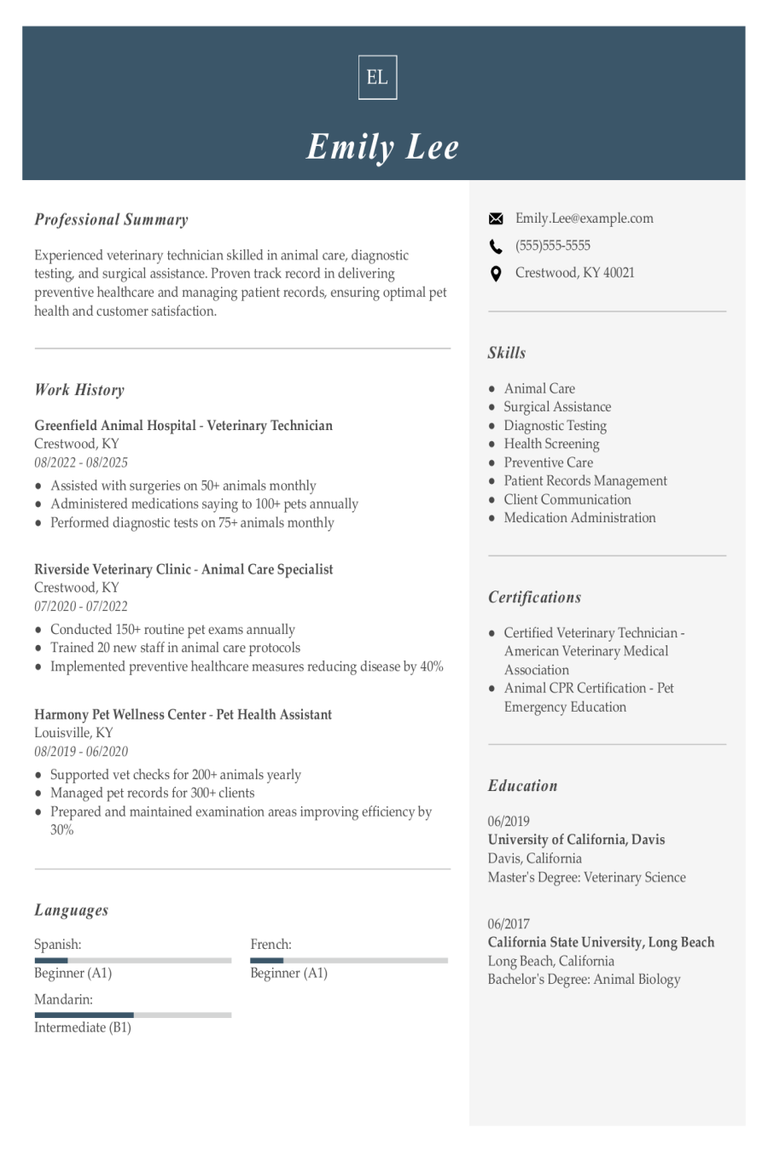
Veterinary Technician Resume Examples & Templates for 2025
Explore veterinary technician resume examples and tips to learn how to showcase your experience caring for animals, assisting vets, and handling lab tests. These samples and tips will help you
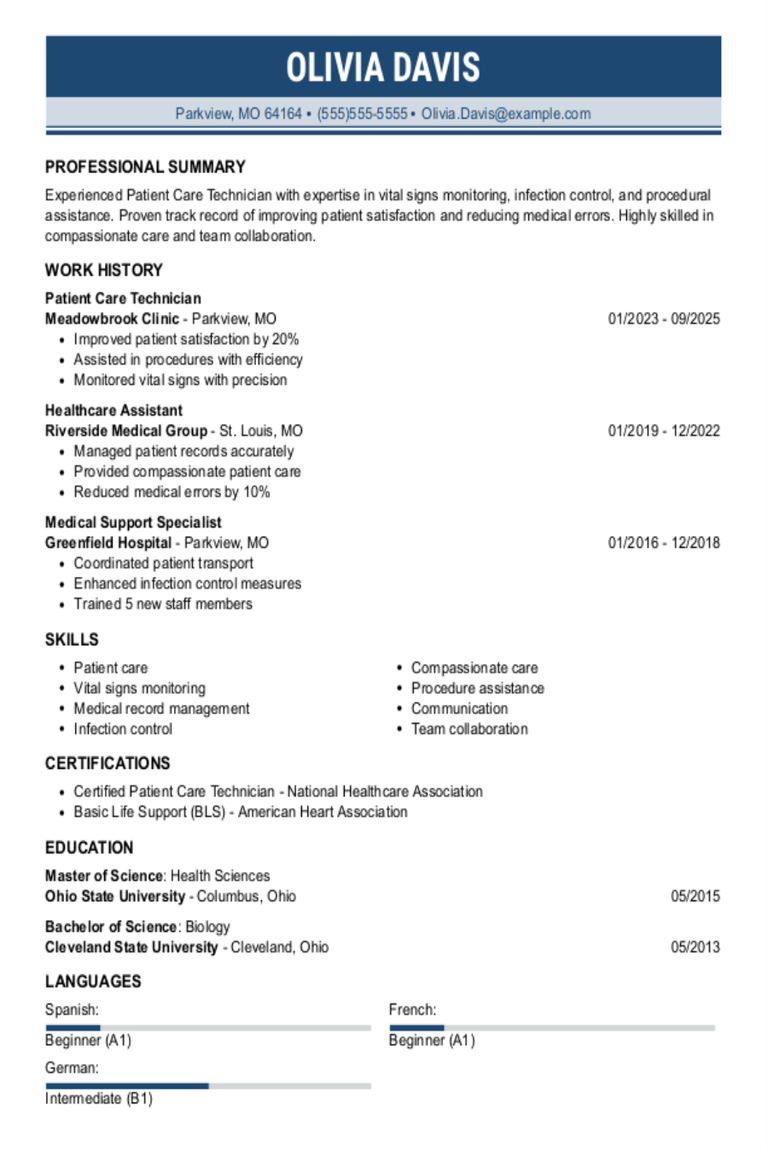
Patient Care Technician Resume Examples & Templates for 2025
Explore patient care technician resume examples to see how to highlight your skills in assisting patients, monitoring vital signs, and supporting medical staff. Discover tips for showcasing your experience in
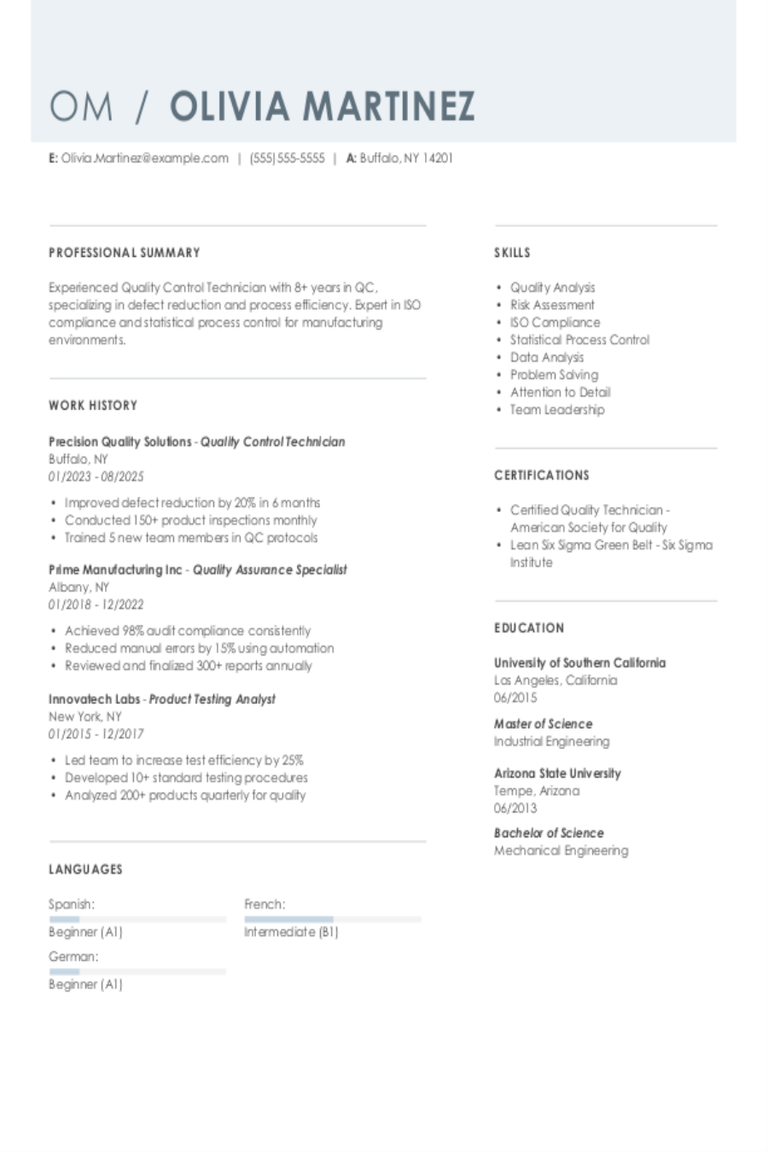
Quality Control Technician Resume Examples & Templates for 2025
Browse quality control technician resume examples to see how to list your skills in testing and inspection. Discover tips on sharing experiences that demonstrate attention to detail and problem-solving abilities
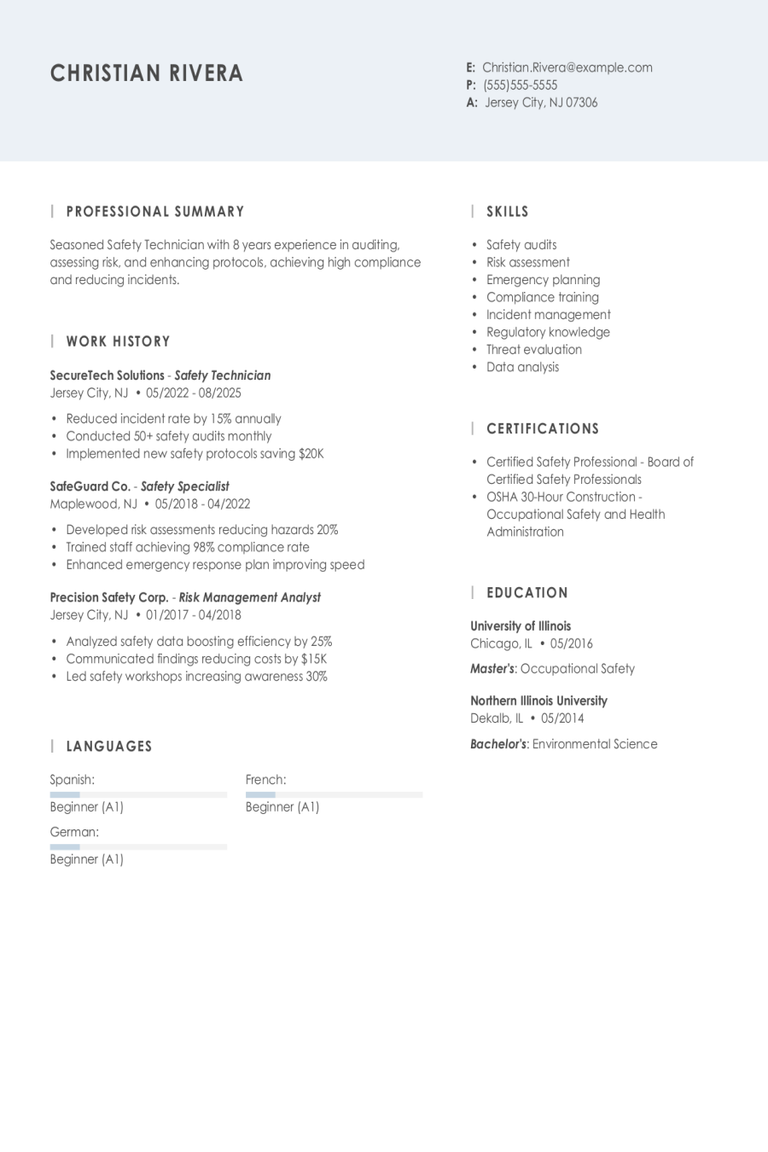
Safety Technician Resume Examples & Templates for 2025
Explore safety technician resume examples that focus on skills like problem-solving, equipment checks, and teamwork. These examples and tips will help you show employers you’re ready to keep workplaces safe
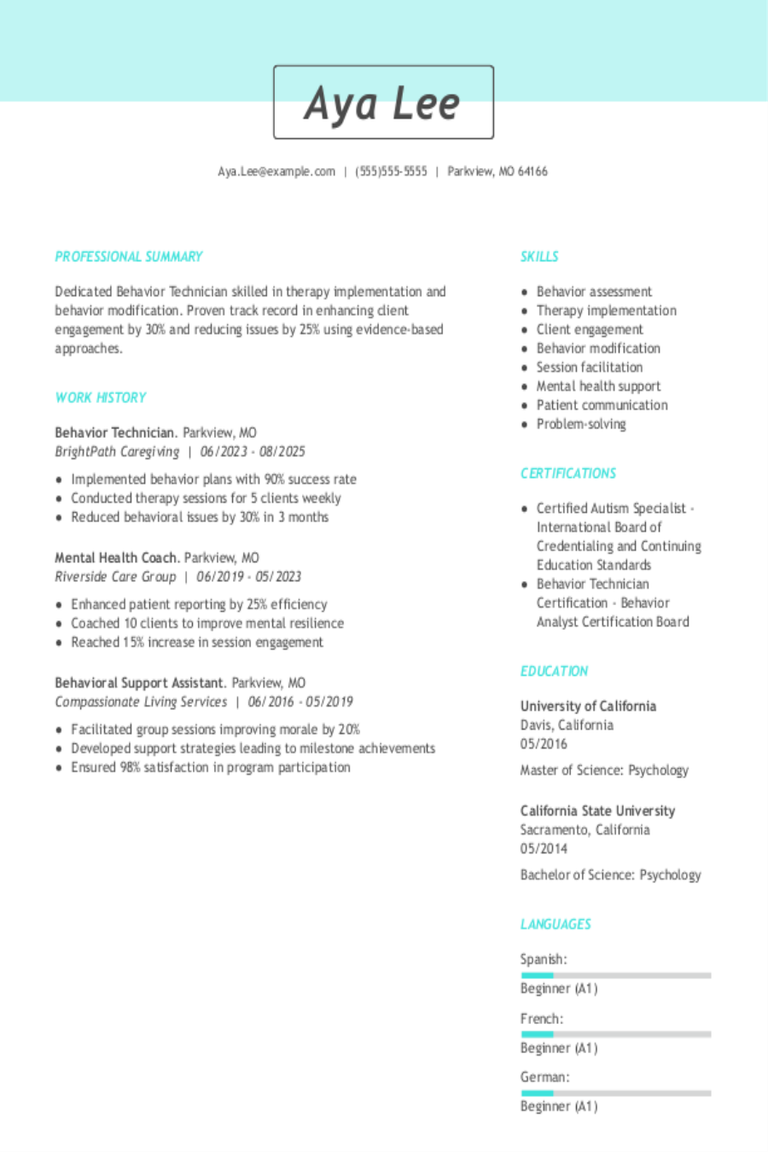
Behavior Technician Resume Examples & Templates for 2025
Discover behavior technician resume examples and learn how to showcase your hands-on experience and make a great impression on potential employers.Build my resumeImport existing resumeCustomize this templateWhy this resume worksQuantifies
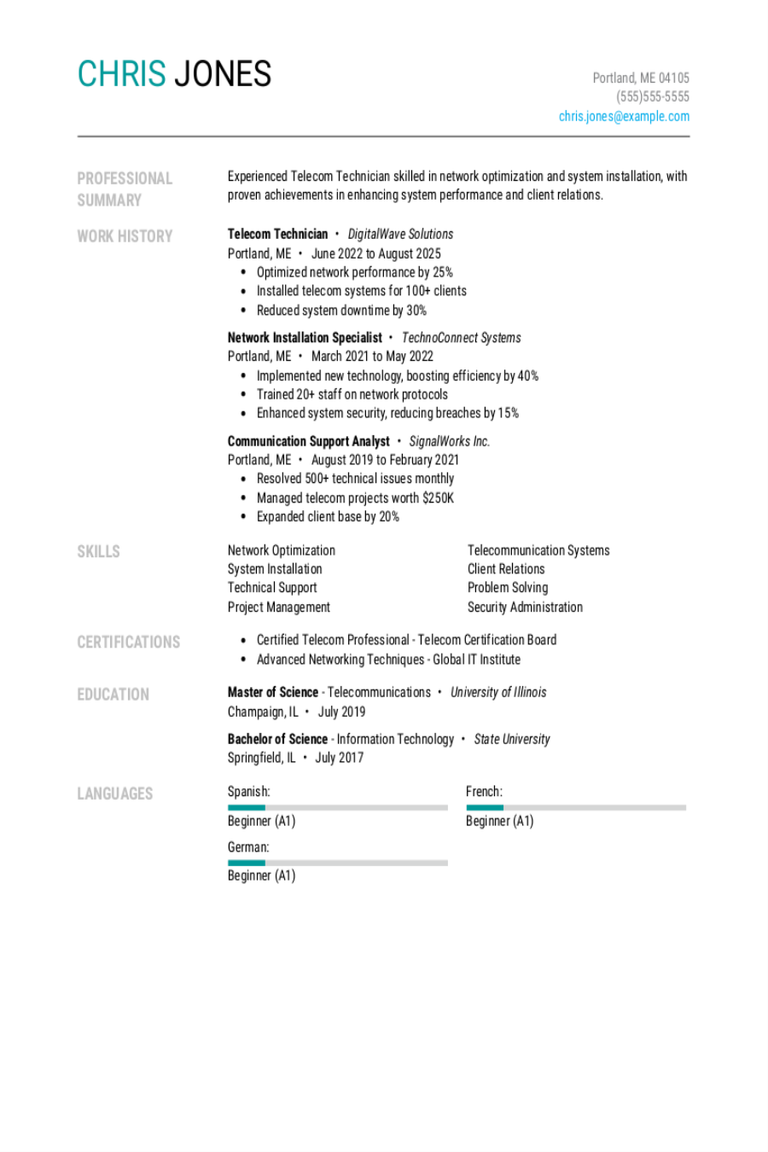
Telecom Technician Resume Examples & Templates for 2025
Browse telecom technician resumes to see how to showcase your experience in fixing and maintaining communication networks, setting up equipment, and solving technical problems. These examples and tips will help
